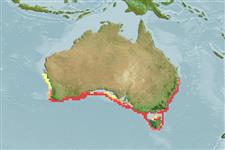Elasmobranchii (sharks and rays) >
Myliobatiformes (Stingrays) >
Urolophidae (Round rays)
Etymology: Urolophus: Greek, oura = tail + Greek, lophos = crest (Ref. 45335).
More on author: Macleay.
Environment: milieu / climate zone / depth range / distribution range
Ecology
Marine; demersal; depth range 100 - 230 m (Ref. 9863). Temperate; 27°S - 44°S, 112°E - 154°E
Eastern Indian Ocean to Western Pacific: endemic to Australia.
Length at first maturity / Size / Weight / Age
Maturity: Lm 50.2, range 45 - 67.5 cm
Max length : 80.0 cm TL male/unsexed; (Ref. 9863)
Large offshore bottom stingaree that occurs on the outer continental shelf and uppermost slope (Ref. 9863, 75154).
Life cycle and mating behavior
Maturity | Reproduction | Spawning | Eggs | Fecundity | Larvae
Last, P.R. and J.D. Stevens, 1994. Sharks and rays of Australia. CSIRO, Australia. 513 p. (Ref. 6871)
IUCN Red List Status (Ref. 130435: Version 2024-2)
Threat to humans
Harmless
Human uses
Fisheries: subsistence fisheries
Tools
Special reports
Download XML
Internet sources
Estimates based on models
Preferred temperature (Ref.
123201): 14.1 - 20.2, mean 15.4 °C (based on 11 cells).
Phylogenetic diversity index (Ref.
82804): PD
50 = 0.5000 [Uniqueness, from 0.5 = low to 2.0 = high].
Bayesian length-weight: a=0.00776 (0.00446 - 0.01352), b=3.10 (2.94 - 3.26), in cm total length, based on LWR estimates for this species & (Sub)family-body (Ref.
93245).
Trophic level (Ref.
69278): 3.6 ±0.4 se; based on size and trophs of closest relatives
Fishing Vulnerability (Ref.
59153): Moderate to high vulnerability (52 of 100).
